Expanding Horizons: Houston Students Embark on Pacific Northwest Adventure
July 25, 2008
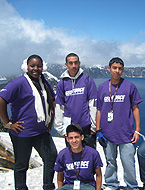
The nation’s largest geoscience pipeline initiative for high school students just got bigger.
This summer, for the first time, 9th and 11th grade students from Houston are taking trips to Washington, D.C. and the Pacific Northwest as part of GeoFORCE Texas. Next year, two more grades will be added, representing all four grade levels. At that point, the program will serve approximately 500 students, twice the size of 2007’s summer program.
GeoFORCE Texas, hosted by the University of Texas at Austin’s Jackson School of Geosciences, is designed to inspire a new generation of college students and the next generation of earth scientists. The program targets high schools with comparatively low statistics for college attendance—21 school districts in the predominantly Hispanic region of southwest Texas and, as of 2008, high schools in the Houston Independent School District. Students receive free field courses lasting from two days to one week, learning science in spectacular and geologically significant locations from Texas, New Mexico and Arizona to Oregon and Washington, D.C.
It takes a large crew to organize and run the GeoFORCE program. As an outreach program coordinator for the Jackson School, I’m one of those people. Here is a travelogue of our week-long trip to the Pacific Northwest with 36 rising 11th grade students from Houston in June, the first trip of its kind for me and for the students.
Day 1: Houston to Portland
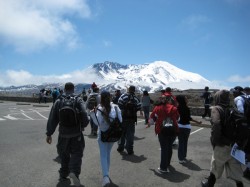
For most of the students, this was their first time on a plane and the first time out of Texas. They were really excited to get on a plane. They screamed when the wheels went up, when we turned, when the flaps moved—just about all the time. Luckily, it was a very smooth flight with almost no turbulence. Coming in to Portland we went right by Mount Hood and Mount St. Helens and had excellent views of both. Students were very impressed and I think they first realized they were “away from home.”
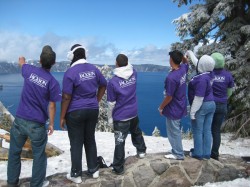
Day 2: Mount St. Helens
Fantastically clear day, students had a great time and really enjoyed the mountain and the experience. We started our day at Mount St. Helens by hiking the Hummocks trail.
The students learned about hummocks (ridges or hills of ice) and hummocky landscapes and then compared and measured different sized rocks to get a better idea of the distribution of rocks. We were able to get a great view of Mount St. Helens from the trail. We then stopped at an overlook and had a short lecture. Students were able to see the lava dome and the ash flows as well as visualize the destruction the eruption caused.
The bus parked near a snow bank and the students had their first experience with real snow; they learned very quickly how to make snow balls! We finally drove up to the Johnston Ridge Observatory, which is about five miles from Mount St. Helens. We ate lunch in the sun and then watched the video of the eruption. Afterwards we listened to a ranger presentation on the eruption outside. We spent the night on the Columbia River near the Washington-Oregon border.
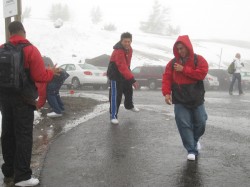
Day 3: Mount Hood
We drove to Mt. Hood the next day. We drove through low clouds and fog and things didn’t get any better once we arrived. We went into the ski lodge and found out that the ski lifts were closed due to 45 mph winds and heavy sleet. We ate lunch in the lodge and then had a short lecture on what they couldn’t see.
Then the students had a 15 minute snowball fight and loved every minute of it. It was hard to get them on the bus. They may not have been able to see anything, but they really enjoyed the time there.
Newberry Volcanic National Monument and Big Obsidian Flow
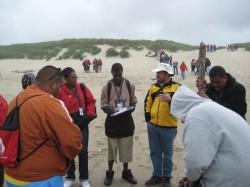
Freezing cold! Students were wearing everything they had – including blankets! The trail was icy and it was about 25 degrees outside. We hiked about a quarter mile up the trail, had a short lecture, and then turned back because the trail was no longer safe. The students wanted to keep going. Some of them got a chance to slide down the trail on the ice. No one threw snowballs—they were that cold.
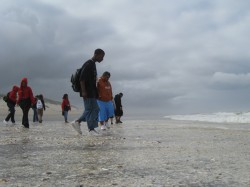
Day 4: Oregon Dunes State Park
Students saw the Pacific Ocean for the first time—for many it was the first time they had seen an ocean—and they loved it.
They did a couple great activities measuring longshore drift and the rate of dune movement. They also wrote their names in the sand and collected sand dollars. We had beautiful weather from here on out.
Tidepooling at Seal Rock
This was an amazing experience for the students. It was a sunny day, with super low tide. A marine biologist from the Hatfield Marine Science Center met us at the beach.
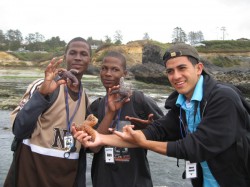
Students were encouraged to collect and touch animals in the tide pools such as sea stars, sea anemones, sea slugs, barnacles, and mussels.
They LOVED it. The students, reminded by the instructors that geology is everywhere, also learned a little about cross-bedding in sandstones.
Day 5: Oregon Coast Aquarium
Again, the students loved it. We went into the shark and ray exhibit, played in the touch tanks, and watched as the sea otters were fed.
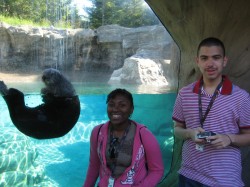
Students’ knowledge of marine biology and ecosystems was enhanced by visiting the aquarium. The interactive exhibits and the diversity of ocean life were very popular.
Glacial Erratic
On the way back to Portland, we stopped off in the Willamette Valley, a farming area with fields of wheat, grape vines and Christmas trees, to see a glacial erratic, a large stone left behind by a retreating glacier.
We discussed glacial erosion and the formation of glaciers. Students also learned how the glacial depositions helped the area become more fertile, and hence a good place for farming.
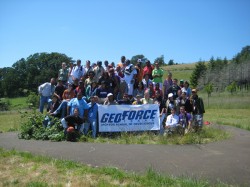
Day 6: Return to Houston
We drove to Portland and caught our flight home to Houston. Since the plane ride was no longer such a novelty, this part of the trip was relatively uneventful.
Day 7: Closing Ceremony
Back home in Texas, the students were treated to a closing ceremony.
COMING SOON: AN ACCOUNT OF THE CEREMONY …
by Danielle Horton
For more information about the Jackson School contact J.B. Bird at jbird@jsg.utexas.edu, 512-232-9623.
